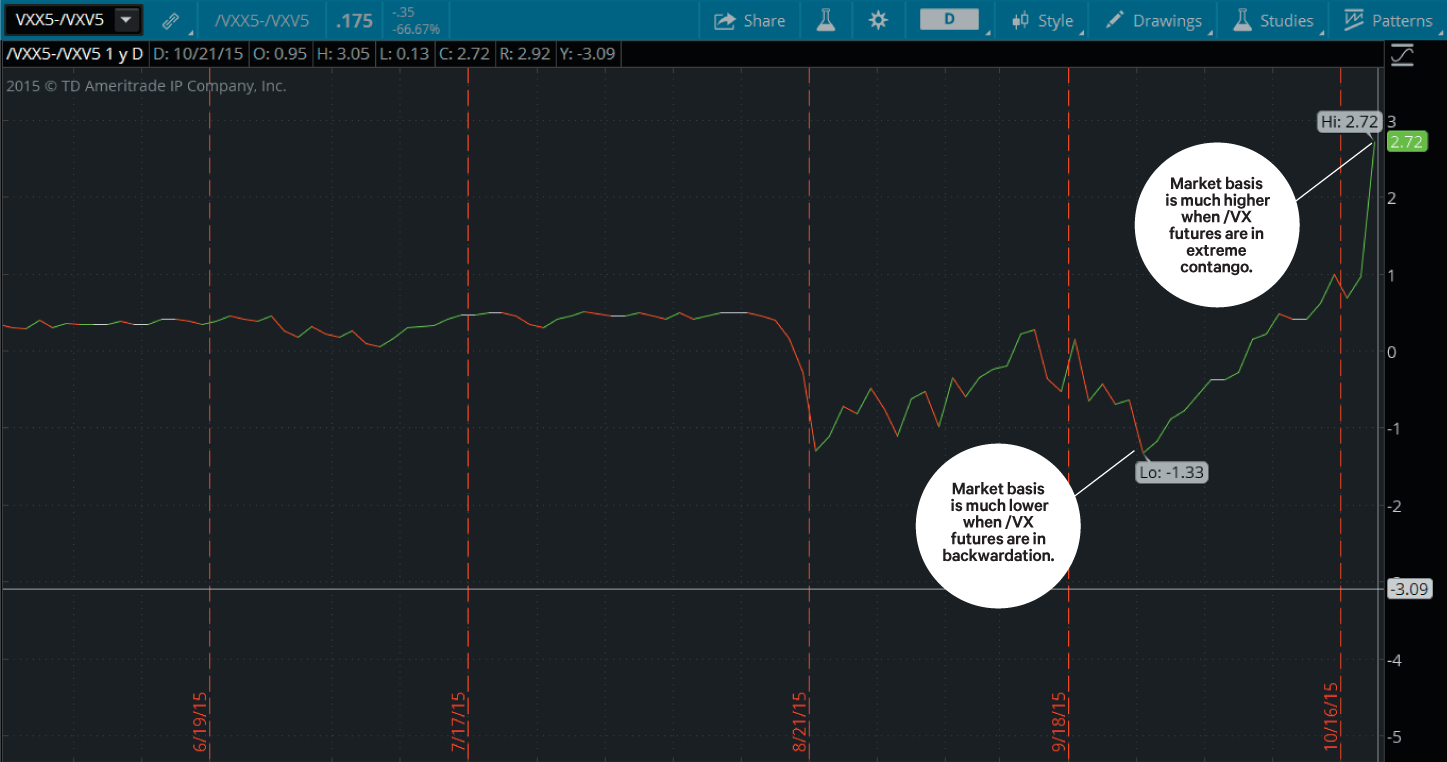Come negoziare future in 3-D:trading di base
I futures possono essere un modo semplice ed efficiente dal punto di vista del capitale per speculare o coprire. Pensi che il prezzo del mais stia aumentando? L'acquisto di un contratto futures sul mais /ZC è un modo più semplice per fare una scommessa rispetto all'acquisto di una fattoria di mais e coltivare la propria. Che ne dici di una copertura a breve termine su un grande portafoglio azionario S&P 500, poco prima di un annuncio della Fed? /ES I futures S&P 500 si adattano a questo progetto. Proprio come le azioni, i futures possono essere operazioni a lungo termine o scalpi veloci. Ma a differenza delle azioni, i futures possono anche offrire diverse opportunità di trading a causa della loro base, che pochi trader privati alle prime armi conoscono.
Base 101
"Base" è il termine per la differenza dei prezzi dei futures in diverse scadenze, o il prezzo in contanti ("spot") del prodotto sottostante e il prezzo dei futures. I prezzi dei futures nelle varie scadenze sono diversi tra loro e dal prezzo spot a causa del costo del carry, e l'impatto della domanda e dell'offerta. Quella differenza rappresenta la base. /ES futures, Per esempio, avere contratti in scadenza a marzo, Giugno, Settembre, e dicembre. / I futures sul mais ZC hanno contratti che scadono a marzo, Maggio, Luglio, Settembre, e dicembre. /ZB obbligazioni, /GC oro e, I futures sul petrolio greggio /CL hanno una propria serie di scadenze.
Base commerciale
In una parola, il trading di base consiste nell'acquistare un future in un mese di scadenza, e venderlo in un mese di scadenza diverso, come vendere marzo /ES e acquistare giugno /ES. È un po' come il trading di coppie intermarket, ma con una correlazione prossima al 100%. Stai speculando sulla base dell'aumento e dell'allargamento, o diminuendo e restringendosi. Poiché i due futures si basano sullo stesso sottostante (es. S&P 500, Buoni del Tesoro, olio crudo, eccetera.), sono altamente correlati. Tendono a muoversi su e giù contemporaneamente. Ma quando non si muovono contemporaneamente, o per lo stesso importo, la base cambia.
Poiché la base può essere negativa, dove il prezzo del future a scadenza ulteriore è inferiore al prezzo del future a scadenza più vicina (noto anche come “backwardation”), è importante sapere in che direzione pensi possa muoversi il futuro a breve termine, rispetto al futuro del mese precedente. Alcuni futures come /ES sono regolarmente in backwardation, quindi l'allargamento della base significa che diventa più negativo. Se pensavi che si sarebbe allargato, potresti prendere in considerazione l'acquisto del futuro a breve termine e lo short sul futuro del mese precedente (ad es. compreresti marzo /ES e a breve giugno /ES).
Quando il prezzo di future a scadenza ulteriore è superiore a quello di future a scadenza più vicina, si chiama "contango". in contago, la base è positiva. Se i future /CL sono in contango, e pensavi che la base si sarebbe allargata, potresti considerare di mettere in cortocircuito il futuro /CL del prossimo mese, e acquistare il futuro /CL del mese precedente.
4 passaggi per ottenere le basi
Per base commerciale, devi vedere le basi Con quello, pensavo nuotando ® ti ha coperto.
1. Nella scheda Commercio di thinkorswim ® , puoi vedere le scadenze dei futures disponibili digitando il simbolo radice (es. /ES) e selezionando “Tutti” dal menu a tendina.
2. Per vedere il prezzo base tra scadenze future consecutive, fai clic sul menu a discesa "Spread" e seleziona "Calendario".
3. Fare clic sulla freccia accanto a uno dei futures per espandere il prezzo base, che è l'ulteriore (o indietro) scadenza, meno la scadenza più vicina.
4. Dal prezzo base che hai appena aperto, puoi tracciare la base facendo clic con il pulsante destro del mouse su "=" prima del simbolo dei futures, e seguendo il percorso di clic “Ulteriori informazioni…”> Grafici TOS> quadrato in alto a sinistra nel menu della griglia del grafico.
FIGURE 1: Source:thinkorswim by TD Ameritrade. Solo a scopo illustrativo.
Basis Trading In the Real World
You may consider the futures basis because they can be traded by themselves, kind of like stocks pairs trades. Per esempio, maybe you don’t have a bullish or bearish bias on the futures’ underlying product itself. But considering the futures basis, you think it might move higher or lower.
Trading the futures basis also has potential advantages over stock pairs trading. Primo, the contract and tick size are the same for a given future. You don't need to adjust the quantities of the trade to account for different contract specification. Secondo, the margin requirement for the basis trades can be lower than for a single long or short future because the basis trade is simultaneously long and short futures. The basis tends to have smaller price changes than the individual future would. So the margin requirement is also smaller.
Let’s look at three futures basis trading scenarios.
Crude Oil (/CL)
Crude oil futures contracts typically go out a couple of years. They’re one of the most liquid, actively traded futures contracts, and the basis can move around a lot. To understand why, think about how crude oil gets turned into gasoline and other “stuff.” It gets pumped out of the ground and transported to a refinery, and that costs money. If the oil is stored, there are insurance and storage fees, as well as interest charges if you’re borrowing money to buy it.
All those things go into the basis of /CL futures, and would make the further-term futures more expensive than near-term futures because those costs are built into the futures’ prices. But with the futures basis, there’s also the expectation of over- or under-supply in the coming months and years. You can see that when you look at /CL futures prices. Backwardation in /CL can happen when the market sees a shortage in crude oil, and where near-term demand outstrips immediate supply. The price of the near expiration /CL future is pushed higher than the back month. But /CL is more often in “contango, ” where the carry costs make the back months slightly higher than the near months, and there is Backwardation in /CL can happen when the market sees a shortage in crude oil, and where near-term demand outstrips immediate supply. The price of the near expiration /CL future is pushed higher than the back month. But /CL is more often in “contango, ” where the carry costs make the back months slightly higher than the near months, and there is equilibrium between supply and demand. If you see /CL in backwardation and you think the causes are temporary, and that /CL will move back to contango, you could consider shorting the near-expiration /CL and buy the further-expiration /CL. The risk, Certo, is that /CL could move further in backwardation, resulting in a loss on the trade. And there’s never a guarantee that contango has to happen in the future. But the trade could be profitable if the futures move back to contango before the expiration of the near-term future.
S&P 500 Index (/ES)
One of the most widely watched and actively traded futures is the /ES contract based on the S&P 500 stock index. /ES trades until 3:15 p.m. CT during “regular” market hours. The price of /ES is based on the value of the stocks in the S&P 500 (which is the SPX index), and the cost to carry the portfolio of those stocks. There is an interest charge to borrow money to buy shares. The interest is offset by dividends that are paid by the S&P 500 stocks.
The net impact of interest and dividends determines the basis between the / ES and the SPX. Nowadays with interest rates low relative to dividends, /ES futures are usually in backwardation, and the basis doesn’t fluctuate much. But because S&P 500 stocks stop trading at 3:00 p.m. CT, così, pure, does the price of the SPX stop updating. And in the 15 minutes between 3:00 p.m. and 3:15 p.m., when the /ES continues to trade, it can move higher or lower than what the basis calculation would suggest based on news that arrives after 3:00 p.m., or on the opening of large positions in /ES in the last 15 minutes of trading that anticipate the next day’s price movement.
If the /ES to SPX basis is $-10, when the /ES moves up relative to where SPX closed and makes the basis $-8, Per esempio, that can signal a stronger open the next day. If / ES moves down relative to the SPX closing price to make the basis $-12, that can signal a weaker open the next day. Looking at the /ES to SPX basis before and after 3:00 pm can give you a clue as to the next day’s opening price action. This may impact stop orders, and even technical indicators you might be tracking.
CBOE Volatility Index (/VX)
Volatility futures might be the trickiest to understand. But they might offer the most interesting opportunities. The CBOE Volatility Index (VIX) is derived from the out-of-the-money SPX option prices. When traders anticipate larger price changes in the SPX (i.e. more volatility), the out-of-the-money SPX option prices can increase in price. Quella, a sua volta, pushes up the VIX. When traders anticipate smaller price changes in the SPX (i.e., lower volatility), the out-of-the-money SPX prices can drop, which in turn drives the VIX lower.
You can’t trade the VIX directly, and /VX futures are a way to speculate on the direction of volatility. But /VX futures are only modestly tied to the VIX. “Modestly” because /VX settles to the VIX settlement value at their expiration. But there isn’t any cost of carry between the VIX and /VX futures be- cause you can’t buy the VIX like you can buy crude oil or a stock portfolio. That makes /VX futures pure indications of how much future volatility the market anticipates. The basis you see between the near and further month in /VX futures reflects whether the market sees more volatility near term or longer term.
Most of the time /VX futures are in contango—where the market expects more volatility the further into the future you look. But when the market panics and drops, generally the VIX rallies the most, the closest expiration /VX future rallies a bit less, and further expiration /VX futures rally a little less than those. That can push /VX futures into backwardation, and make the basis negative.
Figure 2 charts just this scenario, when a market dropped and pushed volatility higher, and the /VX basis became negative.

FIGURE 2:NEGATIVE BASIS
To view basis on /VX, you have to enter it manually as a pair (i.e., longer-term future minus shorter-term future, or /VXX5-/VXV5 as shown above). Most of the time, /VX futures are in contango, as was the case prior to August in the chart. Source:thinkorswim by TD Ameritrade. Solo a scopo illustrativo.
Most of the time, the price of the back-month /VX future is higher than the price of the near-month /VX future, and the basis is positive. When the market became more volatile, the basis became negative. If you believe the market will calm down, and the front-month /VX will drop relative to the back month, and the basis will go from negative to positive, you could consider shorting the front-month /VX future and buy the backmonth /VX future. That trade could be profitable if the basis goes from negative to positive. But the trade would lose money if the basis became more negative—which is something that happened in the 2008 market crisis.
At the closing bell, /VX basis trading isn’t for the faint of heart. If you’re already a proficient futures trader, consider this another tool in the strategy toolbox. But even if you’re not ready to trade it, /VX basis can certainly offer you clues as to how the market is forecasting volatility.
Open a Futures Account
For qualified accounts, you’ll need Level 3 options approval to trade futures. Log in to your account at tdameritrade.com. Under the Trade tab, go to Futures &Forex for more information.
Trading di futures
-
 8 obiettivi di moda che non romperanno la banca
8 obiettivi di moda che non romperanno la banca Sei costantemente in uno stato di avere troppi vestiti senza niente da indossare? Se hai risposto di sì, allora è il momento per un aggiornamento di stile con alcuni nuovi obiettivi di moda. Secondo u...
-
 Che cos'è un'operazione di copertura?
Che cos'è un'operazione di copertura? In finanza, unoperazione di copertura è unazione strategica che gli investitori utilizzano per ridurre il rischio di perdere denaro durante lesecuzione della loro strategia di investimento. Esistono m...
-
Cosa sono le penny stock?
Le azioni Penny sono piccole società le cui azioni vengono scambiate a un prezzo relativamente basso. Possono sembrare economici rispetto ad azioni popolari come Amazon o Apple, ma spesso sono molto p...
-
 Le 3 regole per scrivere e-mail di successo
Le 3 regole per scrivere e-mail di successo Qual è qualcosa che vuoi nella tua carriera? Più clienti? Un nuovo lavoro? Attenzione per la tua app? Più lettori? Qualunque cosa sia, prima che tu lo prenda, devi presentarlo alla persona che può ...




